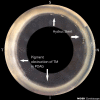How to Stop People from Going Blind from Glaucoma Using Early Cataract Surgery/Refractive Lensectomy and Microinvasive Glaucoma Surgery
- PMID: 35313477
- PMCID: PMC8934161
- DOI: 10.2147/OPTH.S354338
How to Stop People from Going Blind from Glaucoma Using Early Cataract Surgery/Refractive Lensectomy and Microinvasive Glaucoma Surgery
Abstract
Glaucoma continues to be a leading cause of blindness worldwide for the same reasons as in the past several decades, including the lack of early detection, improper treatment, and non-adherence to therapy. Medical therapy continues to be the first-line therapy even as surgical techniques are improving in their safety and efficacy. To turn the tide in preventing blindness from glaucoma, attention must be focused on targeted patient education, screening, effective treatment, and addressing health disparities. To achieve this, early safer cataract surgery and microinvasive glaucoma surgery must be considered as a first-line therapy in addition to medical therapy to best lower both intraocular pressure and the medication burden.
Keywords: MIGS; cataract surgery; glaucoma; lensectomy; prevention.
© 2022 Laroche and Scheive.
Conflict of interest statement
Daniel Laroche is a speaker/consultant for Aerie, Sight Sciences, and Nidek.The authors report no other conflicts of interest in this work.
Figures

References
LinkOut - more resources
Full Text Sources
Miscellaneous

